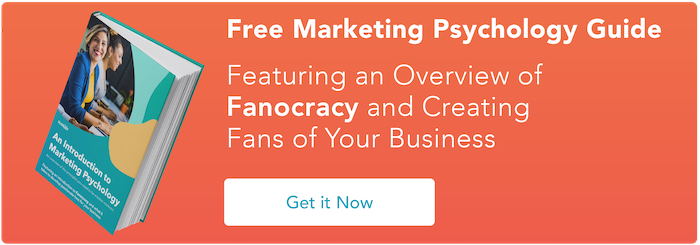But choice is difficult because it also represents sacrifice. Choosing something inherently means giving up something else -- something we might want tomorrow, or next week -- and that won’t be available to us if we don’t grab it today.
So, here's an easy-to-understand guide to choice. It will help you understand the roles of bias, priming, and other psychological quirks in decision-making.
Not only will you be able to make better decisions yourself, but you'll also gain valuable selling and positioning tips that will make your audience more likely to choose the offering you're selling.
What is Choice?
Let’s start with the basics. What is choice, exactly? In its simplest form, choice is the ability to make a decision when you have two or more possibilities. But the theories and mental models about choice go further than that. Here are two of the most common theories on choice:
What is choice theory?
Choice theory is the study of how decisions get made. The term was coined in a book of the same name by William Glasser, who argued that all choices are made to satisfy five basic needs: survival, love and belonging, power, freedom, and fun.
The idea humans primarily make choices that further our own interests is not a new one, and it's seconded by the rational choice theory.
What is rational choice theory?
Rational choice theory is a framework used to model social and economic behavior. According to rational choice theory, individual actors choose whichever option will maximize their interests and provide them with the greatest utility, or benefit.
But Sheena Iyengar, a professor at Columbia Business School who studies choice, posited that choice extends beyond the merits of one particular option or another in her TED talk “On the Art of Choosing.”
“Choice is just as much about who [Americans] are as it is about what the product is,” Iyengar said. “You have a group of people for whom every little difference matters and so every choice matters.”
Underlying these three basic ways of thinking about choice is the assumption we truly understand our preferences and how to weigh them against each other. But what happens when freedom conflicts with power? How do you choose when two options will provide you with equal amounts of fun?
It’s all about preference. And the underbelly of preference is bias.
What is Bias?
Another definition. Bias, according to Merriam-Webster, is either “an inclination of temperament or outlook; especially: a personal and sometimes unreasoned judgment.”
In her TED talk Iyengar, who is blind, recounted a trip to the nail salon where she had to choose between two light shades of pink -- “Ballet Slippers” and “Adorable.” The colors were described to her as an “elegant shade of pink” and a “glamorous shade of pink,” respectively -- semantic choices that hardly illustrate difference.
Iyengar decided to conduct a study with the two colors, asking women to choose which shade they preferred. Half of the study participants couldn’t tell the shades apart. But of the other half, more chose “Adorable” when presented with label-less bottles. On the other hand, when the women knew the names of the polish, the majority chose “Ballet Slippers.”
You’d expect that a nail polish should be judged only by its color. But something about the name “Ballet Slippers” caused women to change their preference.
And that, ladies and gentlemen, is bias.
Why does bias matter?
Some biases are conscious. For example, I prefer dogs over cats -- I think dogs are friendlier, more lovable, and less likely to scratch me. But I don’t know why I prefer the color blue over the color red -- I have an unconscious, also known as implicit, bias.
Implicit bias is everywhere, and it affects the way we act and treat other people -- sometimes to alarming results.
Priming and behavior
In psychology, “priming” is the effect that exposure to one stimulus has on our response to another stimulus. For example, if two groups of people read the word “yellow” followed by either “banana” or “sky,” the group that read “banana” will process the word more quickly than the group that read “sky,” because of the semantic association between the fruit and its color. This unconscious form of association is a large part of how the human brain trains our memories.
Priming can also occur in other circumstances beyond language recognition.
Studies suggest that stereotypes (a form of implicit bias) regarding innate ability linked to gender and/or race impact standardized test performance. A study by Claude Steele and Joshua Aronson found that African-American students performed more poorly on the GRE Verbal exam when they were told the test was a measurement of their intellectual abilities, a phenomenon the researchers termed “stereotype threat.”
Further studies suggest that even the mention of identity was enough to trigger the association.
For instance, Aronson and Steele also found that African-American students who filled out demographic information prior to a test performed more poorly than African-American students who did not. A 2008 study by Kelly Danaher and Christian Crandall found that men’s performance worsened and women’s performance improved on AP Calculus tests if demographic information was filled out after the test was over.
Stereotypes are so pervasive that they don’t even need to be explicitly mentioned to rear their ugly heads. Merely priming students with their group identities was enough to surface societal stereotypes that unconsciously affected performance.
Priming and choice
If priming is powerful enough to cause people's performance to suffer, it’s no surprise that when a conscious choice is involved, people will prefer the option they have a positive implicit bias for.
In 2001, Frederic Brochet conducted a study with 54 participating oenology undergraduates. He asked the students to rate two bottles of red wine, telling them only that one was expensive and one was cheap. In reality, Brochet had filled both bottles with the same cheap wine. The students described what they believed to be the expensive wine as “complex and rounded,” but the cheap wine as “weak and flat.”
Similarly, in a Dutch study, subjects watched what they were told was a high-definition program in a room with posters touting high-definition images. After the program, they reported their experience was superior to standard-definition programming. You probably won’t be surprised to learn that they were, in fact, watching standard definition.
We’re taught to prefer higher-quality products, and associate quality with indicators like price and modernity. The trouble with these associations is they can overrule the quality of the products we’re choosing between. It’s the classic signal vs. noise problem -- how do we separate bias from choice?
Bias and choice
Bias doesn’t just refer to a belief or judgment about a specific thing (i.e. that I like dogs better than cats). In psychology, “bias” also refers to behavioral tendencies that affect how we reach conclusions and ultimately make choices. Here are four cognitive biases that unconsciously affect how we make decisions.
1. Anchoring Bias
We tend to “anchor” our decisions based around the first piece of information we receive. For example, if you’re used to paying $10 for shampoo and see it on sale for $8, this reduced price will feel like a deal. However, your friend’s local store sells the same shampoo for $12, so she will view the $10 bottle as the deal.
2. Framing Effect Bias
The manner in which choices are presented to us also affects how we view them. A study had participants watch a traffic accident and asked: “About how fast were the cars going when they contacted each other?”
The researchers then replaced the verb “contacted” with “hit,” “bumped,” “collided,” and “smashed” for different groups of participants. As the intensity of the action verb increased, so did the participants’ speed estimates. They guessed that the cars were going 31, 34, 38, 39, and 41 miles per hour, respectively.
3. Ingroup Bias
Also known as the bandwagon effect, ingroup bias occurs when a person in a group acts in a similar way to other members of that group.
Interestingly, the bias exists across arbitrarily created groups (such as through a coin toss) in addition to groups based around religion or sports, among other affiliations.
4. Loss Aversion Bias
People don’t like to lose or miss out on things. Loss aversion causes us to feel more strongly about avoiding a loss than receiving a gain, and explains the endowment effect, our tendency to prefer things we already own over things we don’t.
In a study conducted by Daniel Kahneman, participants were given mugs, chocolate, or nothing, and given the option to either trade their wares, or choose one of the two items if they had started with nothing. About half the participants who started with no items chose mugs, but 86% of those given mugs to begin with stuck with that item.
5. Ambiguity Bias
This bias draws on humanity's innate aversion to risk. Let's say you have two music choices. You could listen to an album you've heard before and enjoyed or one you've never listened to.
While the section option could turn out to be your new favorite album, it could also be an assault on your ears. The ambiguity effect is what would make many of us choice the first, more familiar option.
Learn more about psychological biases here >>
Why Choice Is So Hard
Three months ago, I packed up all my things and moved out of the city I've lived in for 23 years to work at HubSpot, a company whose existence I'd only recently discovered.
Yesterday, I bought two kinds of cheese I'd never tried before from the grocery store.
Choosing the wrong kind of a cheese is a smaller (and less costly) mistake than choosing the wrong job. It’s also a mistake that’s much easier to reverse. And yet the decision to move and change jobs felt far, far easier than my cheese selection.
Why?
Choice overload
A supermarket has an average of 42,686 different SKUs. I’m not a psychologist, but I can safely say that having 42,686 choices is overwhelming.
In her TED talk “How to Make Choosing Easier,” Iyengar describes a problem she calls “choice overload.” She conducted a study at a grocery store in Palo Alto, which carried 348 varieties of jam.
Iyengar set up a tasting booth outside the store. When the booth had six varieties of jam, patrons were 33% less likely to stop and sample the products than if 24 varieties were displayed. But the patrons who stopped at the six-variety booth were six times more likely to buy jam than the patrons who stopped at the 24-variety booth.
What’s the takeaway? More choices might capture consumers’ attention, but sheer variety is actually harmful in converting them to customers.
“We might enjoy gazing at those giant walls of mayonnaises, mustards, vinegars, and jams, but we can’t do the math of comparing and contrasting and actually picking from that stunning display,” Iyengar said.
Choice and willpower
I’m trying to pare down decisions. I don’t want to make decisions about what I’m eating or wearing, because I have too many other decisions to make. - Barack Obama, on why he only wears grey or blue suits
Obama isn’t the only leader who follows this logic. Facebook cofounder and CEO Mark Zuckerberg and late Apple cofounder and CEO Steve Jobs wore the same outfits every day as well.
It’s not because the three men have poor fashion sense -- it’s because they understood that making decisions causes mental fatigue.
An interesting example comes from a 2010 study by Jonathan Levav and Shai Danziger. According to the research, Israeli parole boards granted parole to around 70% of prisoners who appeared before them early in the morning, but less than 10% of prisoners who appeared late in the day.
“The more choices you make throughout the day, the harder each one becomes for your brain, and eventually it looks for shortcuts,”John Tierney of the New York Times wrote of the study.
As you make more decisions throughout the day, your reserve of willpower eventually becomes depleted. As you become more fatigued, you’ll start to either make decisions impulsively instead of carefully thinking through consequences, or wind up doing nothing due to a lack of energy to weigh options. In the case of the parole board, it was easier to stick with the status quo and keep prisoners incarcerated, instead of chancing release and recidivism.
In short: The more decisions -- simple or complex -- you are subjected to, the less mental energy and willpower you have left at the end of the day.
And this finding has widespread implications. Take, for instance, the connection between decision fatigue and impulse eating.
Tierney writes of people trapped in poverty:
[Economist Dean] Spears urges sympathy for someone who makes decisions all day on a tight budget. In one study, he found that when the poor and the rich go shopping, the poor are much more likely to eat during the shopping trip. This might seem like confirmation of their weak character -- after all, they could presumably save money and improve their nutrition by eating meals at home instead of buying ready-to-eat snacks. But if a trip to the supermarket induces more decision fatigue in the poor than in the rich -- because each purchase requires more mental trade-offs -- by the time they reach the cash register, they’ll have less willpower left to resist the Mars bars and Skittles. Not for nothing are these items called impulse purchases.
So, next time you need to make a big decision (like whether you’re going to move to a different city and accept a new job), it might not be a good idea to go looking for a new kind of cheese at the grocery store.
How to make hard decisions easier
At this point, you get it. Choice is hard. There are some decisions that will never be easy. Think of Neo, the protagonist from The Matrix, faced with the option to swallow a red pill and discover a harsh reality, or take the blue pill and stick with a comfortable fantasy.
For marketers and salespeople, however, there are concrete, actionable ways to make the buying process easier for their prospects. Taken from "How to Make Choosing Easier," here are Iyengar’s four lessons for how to take the pain out of decision-making.
1. Cut
Less really is more. Faced with choice overload, people are less likely to buy. The trick is to find the balance between having enough options to attract buyers in the first place, but not so many that consumers become overwhelmed and walk away.
It's difficult, but if a company can find that sweet spot, they'll reap the rewards. When Proctor & Gamble cut their Head & Shoulders line from 26 products to 15, the organization saw a 10% increase in sales.
2. Make Things Concrete
“In order for people to understand the differences between choices, they have to be able to understand the consequences associated with each choice,” Iyengar said. “The consequences need to be felt in a vivid sort of way.”
So, if consumers are able to connect with a product on a visceral level, they will be more likely to buy it. Consider that consumers spend 15% to 30% more money when using a credit or debit card rather than cash because of this lack of concreteness -- swiping a piece of plastic is a different experience than handing the cashier a $20 bill.
3. Categorize
Think back to that grocery store with its 42,686 products. Imagine if the 2% milk was next to shampoo, but whole milk and heavy cream were stored next to meat.
It would be chaos.
Separating products into discrete categories prevents choice overload by slimming down the number of products consumers have to compare to each other. It's also worthwhile to note the total number of products we have to choose from matters less than the number of product categories with which we’re presented.
“If I show you 600 magazines and divided them up into 10 categories, versus 400 magazines in 20 categories, you believe that I have given you more choice and a better choosing experience if I gave you the 400 than if I gave you the 600,” Iyengar said. “The categories tell me how to tell them apart.”
4. Condition for Complexity
If I told you to design your own car, where would you start?
A German car company that allows consumers to completely customize their own cars found that presenting choices with fewer options first and slowly building up to more complex decisions -- such as picking from 56 different exterior car colors -- kept consumers more engaged.
Choice may be hard, but our brains are capable of astoundingly complex calculations -- researchers needed 82,944 processors to simulate a single second of human brain activity. Building up from the simple choices to more complex ones, however, is necessary to prevent dropoff during the buying process.
5. Set a Deadline
Parkinson's Law theorizes that work expands to fill the time available for completion. So, if you have a 5:00 PM deadline, you'll work until 5:00 PM. If you have a 2:00 PM deadline, you'll get the same amount of work done by 2:00 PM.
Use this framework to streamline your decision making process. If you need to choose a vendor and just can't make up your mind -- set yourself a deadline for making the decision, and stick to it.
The reasons we make decisions are not always rational and can’t be isolated from who we are, where we are, or maybe even how long it took us to decide what outfit to wear that morning. But by being aware of the psychological factors that affect our choices -- and recognizing how a decision we make at 8 a.m. affects one at 3 p.m. -- we’ll be able to not only make better decisions for ourselves, but help others do the same.
How People Make Decisions



![The Psychology of Customer Perceived Value [Infographic]](https://53.fs1.hubspotusercontent-na1.net/hubfs/53/380_Customer%20Perceived%20Value.png)

![7 Cognitive Biases Salespeople Must Know to Close Deals [Cheat Sheet]](https://53.fs1.hubspotusercontent-na1.net/hubfs/53/00-Blog_Thinkstock_Images/cognitive-biases-close-more-deals-cheatsheet-514637-edited.jpg)
![20 Weird Cognitive Biases Influencing Your Buyer's Decision [Infographic]](https://53.fs1.hubspotusercontent-na1.net/hubfs/53/biasstockphoto.jpg)
